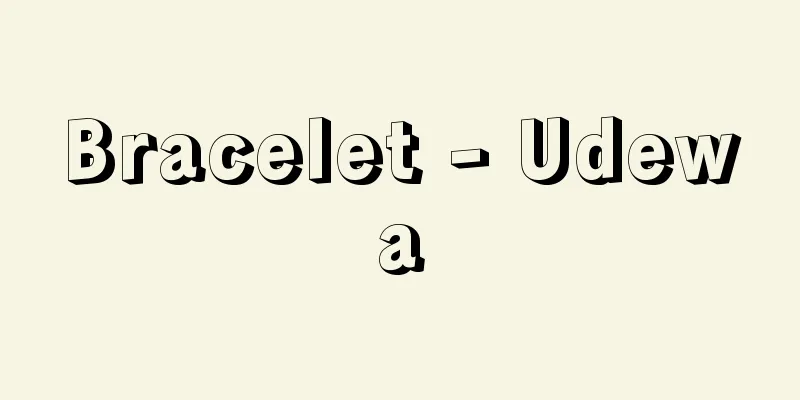Bracelet - Udewa

|
Jewelry such as rings, chains, and bands worn on the wrist or arm. Properly speaking, a bracelet is worn on the wrist, and an armlet is worn on the arm (especially the upper arm), but the term also includes anklets worn on the ankle. They have been used by both men and women along with rings and necklaces since prehistoric times, and around 3500 BC, bracelets made of linked shells were already seen. In ancient Egypt, after changes such as ivory and bronze, gold bracelets appeared and were loved by the upper classes. They were wide and beautifully carved, with two or three strands, or made of glass or beads. In Mesopotamia, there were luxurious bracelets combining gemstones such as turquoise, lapis lazuli, agate, and pearls, and in the Cretan civilization there were snake-shaped bracelets made of gold, silver, and copper to ward off evil. In the Etruscan region, delicate granular goldwork was developed, which was inherited by ancient Rome. In the 12th century, gorgeous bracelets inlaid with pearls, sapphires, emeralds, and rubies could be seen for women, but as clothing sleeves became longer in the Middle Ages, bracelets disappeared for a time. They reappeared and became popular around the end of the 15th century, but from the 17th century onwards they became an accessory exclusively for women. The custom of wearing them over long gloves with evening wear began in the 19th century. However, today, like rings and necklaces, bracelets are prominently worn by men, especially young people. In Japan, both men and women have loved bracelets since the Stone Age, and they were widely used from the Kofun period through the Nara period. The oldest type is a shell bracelet, made by slicing thick bivalve or snail shells into rings and polishing them. Bracelets from the Kofun period were called hijimaki and were made of copper, beads, stone, and shell. Bracelets made from bronze or copper were called kanakushiro and were often ring-shaped with bell-like notches on the outside. Suzukushiro were bronze bracelets with small bells attached around them, and came with five or six bells. Those made of round stones or tube beads were called tamakushiro. Stone bracelets made from kuwagataishi stones or sharinseki stones were apparently used as ritual implements. Later, bracelets plated with gold and silver also appeared. The statue of Kichijoten at Yakushiji Temple in Nara, painted during the Tenpyo period, is wearing bracelets on both hands. After that, there was no room for bracelets in Japanese clothing, so they were not worn for a long time, but in the 1880s, bracelets were imported from the West. However, compared to other accessories, they were slow to catch on, and it was not until after World War II that they finally became popular. Generally speaking, bracelets flourished in times and ethnic groups with simple clothing styles that exposed a lot of skin. In modern times, they are also used with long-sleeved clothing, but when wearing short-sleeved or sleeveless clothing, they are favored as an effective accessory that accentuates the look of the hands. They are made of a wide variety of materials, including precious metals, metals, gemstones, stones, bones, tusks, shells, wood, nuts, glass, leather, plastic, beads, and braided cords, and come in a wide variety of designs. There are three basic types: (1) Bangle bracelet: A simple decorative ring without a clasp. (2) Clip bracelets: These are rings that open and close with a hinge or clasp. They are also called hinge bracelets. (3) Flexible bracelets: These can be put on and taken off without opening or closing, using mechanisms such as chains or springs, or the elasticity of the material. Spiral and snake-shaped bracelets are examples of this type. Other than the above, there are chain bracelets (braided chains or metal, also called ring bracelets), charm bracelets (with pendants such as talismans), love bracelets (with heart-shaped or Cupid-shaped ornaments), and slave bracelets (wide bands that fit snugly on the arm, or a group of several thin gold rings). Today, there are bracelet watches with added practicality, identification tag bracelets with self-identification tags (also called life bracelets), and magnetic bracelets with health benefits. In addition to traditional styles, it is also popular to repurpose necklaces into bracelets and wear them in pairs for both men and women. [Hirano Yuko] Special features of the braceletWhen we take a general look at the peoples of the world, we find that bracelets adorn the arms of many different kinds of people, both young and old, men and women, are widely loved throughout society, and have many other meanings beyond being merely decorative. For example, around the middle of the 20th century, the Xavante people, who live in the depths of the Amazon in Brazil, are said to have worn rope-like bracelets made of woven palm fiber. They also wrapped similar ropes around their ankles, necks, and waists, and these were the only things they traditionally wore on a daily basis; they did not wear clothes. For them, these accessories may have had a meaning beyond decoration. In ancient times, limbs, protruding parts, and joints of the human body were often considered sacred as entrances and exits for spirits and evil spirits. The wrists and arms are such parts, and bracelets worn on them are often thought to have religious or magical powers. In other words, by wearing a bracelet, one's own spirit is fixed in the body, or evil spirits are prevented from entering, thus warding off illness. In societies before the development of modern medicine, infant mortality rates were particularly high, and some bracelets were only worn during infancy, when children were more susceptible to disease. In Southeast Asia, such as Thailand, gold and silver bracelets for children were once common. In this case, the bracelet was a kind of amulet, but also indicated the stage of the wearer's life development. The function of the latter bracelet can be summarized as a function of expressing social status. One example is that in the Dehong area of Yunnan Province, China, boys of Dai descent used to wear a silver bracelet on their left wrist when they became young adults. Also, owning a bracelet made from a rare material that is difficult to obtain can show off the owner's privileged status. In the famous "Kura" trading system that developed between the islands east and north of New Guinea, the white shell bracelet "Mwari" played an important role as a medium of ceremonial exchange along with the necklace "Souraba." It was an honor to own a "Mwari," but it was not permitted to keep it for long periods of time. The "Kura" was maintained by the bracelet traveling from island to island in a certain direction, during which various daily necessities were traded. [Hiroko Yokoyama] In Japan, they can be seen in the Jomon, Yayoi and Kofun periods. Shell bracelets are prominent in the Jomon period, but wooden bracelets were also used. They are made by drilling holes in bivalve shells such as ark shells, ark shells and kasugai shells, leaving the edges open, and creating rings, as well as snail shells such as anakinawa shells cut vertically, and are often excavated while still attached to buried human bones. Some are painted vermilion, suggesting a magical significance. In the Yayoi period, shells from the southern seas such as the gohora, cone shells and giant otsutanohagai shells became popular, and bronze bracelets also appeared. All of these have strong ritual significance. Occasionally, bracelets made of glass are also found. In the early Kofun period, along with shell bracelets, stone bracelets made from jasper, wheel stones, and shovel-shaped stones appeared. These were not practical items, but were seen as treasures or ritual objects with magical significance. In the later period, metal (copper, bronze, gold, silver) bracelets were developed, and bell bracelets with several bells attached and glass bracelets also appeared. There were also many so-called hand bracelets (tama bracelets) made of round and small beads strung together, and they became increasingly diverse. The way these were worn can be seen in Haniwa clay figurines depicting people. [Teramura Mitsuharu] [Reference]Snake-shaped bracelet. 300-250 BC, gold, diameter 8.5 cm, Hellenistic period, owned by the Metropolitan Museum of Art , Greece. ancient greek bracelets Source: Shogakukan Encyclopedia Nipponica About Encyclopedia Nipponica Information | Legend |
|
手首や腕につける輪、鎖、バンドなどの装身具。正しくは手首につけるのがブレスレットbracelet、腕(とくに上腕)につけるのはアームレットarmletであるが、ときには足首にはめるアンクレットankletも含めていう。原始時代から指輪やネックレスとともに男女の区別なく用いられ、紀元前3500年ごろにはすでに貝殻を連ねたブレスレットがみられる。古代エジプトでは象牙(ぞうげ)や青銅などの変化を経て、黄金製のものが登場し、上流階級に愛好された。美しい彫刻が施された幅広のもの、2連、3連のもの、あるいはガラスやビーズ製もあった。メソポタミアではトルコ石、ラピスラズリ、めのう、真珠などの宝石を組み合わせた豪華なもの、クレタ文明の時代には金、銀、銅製の魔除(まよ)けの意味をもつ蛇形のブレスレットがあった。またエトルリア地方には繊細な粒金細工が発達し、これらは古代ローマに受け継がれた。12世紀には真珠、サファイア、エメラルド、ルビーなどで象眼(ぞうがん)した女性用の華麗なものがみられるが、衣服の袖(そで)が長くなる中世になると、ブレスレットは一時姿を消した。15世紀末期ごろからふたたび登場して一般化するが、17世紀以後はもっぱら女性専用の装身具となった。夜会服などで長手袋の上からはめる習慣は19世紀からである。しかし今日では若者を中心に、指輪やネックレス同様、男子の使用も目だっている。 日本では、石器時代から男女ともに腕輪を好み、古墳時代から奈良時代を通じて盛んに用いられた。最古のものは貝輪で、厚みのある二枚貝や巻き貝を輪切りにして磨いたものである。古墳時代の腕輪は釧(くしろ)(ひじまき)とよばれ、銅、玉、石、貝製などがあった。青銅や銅でつくったものは銅釧(かなくしろ)とよび、外側に蛇腹(じゃばら)のような刻み目のある輪形が多い。鈴釧(すずくしろ)は銅釧の周囲に小さな鈴をつけたもので、5鈴、6鈴がある。丸石や管玉(くだたま)をつないだものは玉釧(たまくしろ)。鍬形石(くわがたいし)や車輪石(しゃりんせき)を使った石釧は祭器として使用されたらしい。のちには金銀のめっきをしたものも現れた。天平(てんぴょう)時代に描かれた奈良・薬師寺の吉祥天女(きちじょうてんにょ)像は両の手に腕輪をつけている。その後日本の衣服には腕輪をつける余地がなく、久しく中断していたが、明治20年代に西洋からブレスレットが輸入された。しかし他の装身具に比して広まるのが遅く、第二次世界大戦後になってようやく流行し始めた。 概してブレスレットの隆盛は、衣服の裸出部の多い単純な服型の時代や民族にみられる。現代では長袖の衣服のときにも用いるが、短い袖あるいは袖なしの衣服を着た場合には、手の表情にアクセントをつける効果的な装身具として愛好されている。素材は、貴金属、金属、宝石、石、骨、牙(きば)、貝、木、木の実、ガラス、革、プラスチック、ビーズ、組紐(くみひも)など、デザインは多種多様である。 基本型としては次の3種がある。 (1)バングル・ブレスレット 留め具のない単純な飾り輪。 (2)クリップ・ブレスレット 蝶番(ちょうつがい)や留め具によって開閉する輪形。ヒンジ・ブレスレットともいう。 (3)フレキシブル・ブレスレット 鎖、ばねなどの仕掛けや素材の弾力性を利用して、開閉せずに着脱できるもの。スパイラル(螺旋(らせん)形)やスネーク(蛇形)もこの種である。 以上のほかに、チェーン・ブレスレット(鎖や金属を編んだもの、一名リング・ブレスレット)、チャーム・ブレスレット(魔除けなどの垂れ飾りをつけたもの)、ラブ・ブレスレット(ハート形やキューピッドの飾りをつないだもの)、スレーブ・ブレスレット(腕にぴったりはまる幅広のバンド状、あるいは数個の細い金環をまとめたもの)などがある。今日的なものでは、実用性を付加したブレスレット時計、自己証明タグを取り付けた認識票ブレスレット(一名ライフ・ブレスレット)、健康効果のある磁気ブレスレットといったものもある。従来の装い方に加えて、ネックレスをブレスレットに転用したり、男女ペアで用いたりすることも流行している。 [平野裕子] 腕輪の特殊な機能世界の諸民族を概観すると、腕輪が老幼男女さまざまな種類の人々の腕を飾り、また社会全般に広く愛好されていたり、あるいは単なる装飾品にとどまらずにそのほかの多様な意味を有している状況に出会う。たとえば20世紀のなかばごろブラジルのアマゾン奥地に住むシャバンテの男女は、ヤシ類の繊維で編んだ縄紐(なわひも)状の腕輪をしていたという。彼らは同様の縄紐を足首や首、あるいは腰にも巻き付けており、これらが彼らが伝統的に日ごろから身につけていた唯一のもので、服はまとっていなかった。彼らにとってこれらの装身具は飾り以上の意味をもっていたかもしれない。 人間の身体の各部分のうち、四肢や突出部あるいは節目は、古来、しばしば霊魂や悪霊などの出入口として神聖視されることがあった。手首や腕もそういう部位にあたり、したがって、そこにつける腕輪は、宗教的、呪(じゅ)的な威力をもつと考えられることが多い。つまり、腕輪をすることにより、自分自身の霊魂を肉体内に定着させたり、あるいは悪霊の侵入を阻止したりして、病魔から逃れるのである。近代医学の発達以前の社会においては幼児死亡率がとりわけ高く、病害に冒されやすい幼児期にのみ着用される腕輪というのもあった。東南アジアのタイなどでは子供用の金製や銀製の腕輪がかつてはよくみかけられた。この場合の腕輪は一種の御守りであると同時に、さらに着用者が人生の成長過程のどの段階にあるかを示すものにもなる。この後者の腕輪の機能は、社会的地位を表現する機能としてまとめられる。中国雲南省徳宏地区のタイ(傣)系の男子が子供から若者になると、かつては銀の腕輪を左手首にはめたというのもその一例である。 また、入手しにくい貴重な材料によってつくられた腕輪を所有することで、所有者の特権的地位が誇示されることもある。あるいはまた、ニューギニアの東方および北方の島々の間で繰り広げられた交易システムとして有名な「クラ」においては、白い貝の腕輪「ムワリ」が儀礼的交換の媒体として首飾り「ソウラバ」とともに重要な役割を果たした。「ムワリ」を所有することは名誉なことであるが、長期間手元に置くことは許されない。それが一定の方向で島から島へと巡回していくことによって「クラ」は維持され、その際に各種の日用品の交易が行われたのである。 [横山廣子] 日本では縄文・弥生(やよい)・古墳の各時代にみられる。縄文時代は貝輪が顕著で、ほかに木製などもある。アカガイ、サルボウガイ、ベンケイガイなどの二枚貝に孔(あな)をあけ、周縁部分を残して環状につくったもの、アカニシなどの巻き貝を縦に切ったものなどがあり、埋葬人骨に着装されたまま出土することも多い。朱彩のものもあり、呪術(じゅじゅつ)的意味がうかがわれる。弥生時代になると、ゴホウラ、イモガイ、オオツタノハガイなど南海産の貝が好んで用いられ、また新たに銅釧が出現する。いずれも祭祀(さいし)的意味合いが強い。まれにガラス製釧もある。古墳時代になると、前期は貝製釧とともにその系譜を引く碧玉(へきぎょく)製の石釧(いしくしろ)、車輪石(しゃりんせき)、鍬形石(くわがたいし)の石釧などが現れる。これは実用品ではなく、呪術的意味をも有す宝器、儀器とみられている。後期には金属製(銅、青銅、金、銀製)の腕輪(釧)が発達し、数個の鈴をつけた鈴釧(すずくしろ)やガラスの釧もみられる。ほかに丸玉、小玉などの玉類を連ねたいわゆる手玉(玉釧)も多く、多種多様化してくる。これらの着装法は、人物埴輪(はにわ)などからその実際を知ることができる。 [寺村光晴] [参照項目] |蛇形のブレスレット。紀元前300~前250年ころ 金 径8.5cm ヘレニスティック期 ギリシアメトロポリタン美術館所蔵"> 古代ギリシアのブレスレット 出典 小学館 日本大百科全書(ニッポニカ)日本大百科全書(ニッポニカ)について 情報 | 凡例 |
Recommend
Sliven - Sliven (English spelling)
The capital of Sliven County in central-eastern B...
Turmeric
A yellow dye extracted from the rhizomes of turme...
Freidank (English spelling)
[raw]? [Died] about 1233. A medieval German aphori...
Leona Esaki
Physicist. Inventor of the tunnel diode, also kno...
Kanna River
A river that flows through the southwestern part ...
Astronomical unit - Tenmontan-i
A unit of length used in astronomy. The average d...
Deutsche Edison-Gesellschaft für angewandre Elektricität
…[Ryozo Aoki]. … *Some of the terminology explana...
Levi ben Gerson
...Scholars who adopted Neoplatonism into Judaism...
Cotta Company (English name) JG Cotta's Company
A German publishing house founded in Tübingen in 1...
Pyrus communis (English spelling)
… [Yukio Taniguchi]. … *Some of the terminology t...
blastopore
…When an amphibian egg is fertilized, it divides ...
Mr. Yamaguchi
A feudal lord in the early modern period. Born in ...
Inner Mongolia Autonomous Movement Federation - Uchimokojichi Sports Federation
...After that, with the establishment of the &quo...
weeping willow
...The leaves are broadly linear, entire, and oft...
Numismatic Chronicles
…The Paleogene was proposed by CF Naumann (1866) ...









